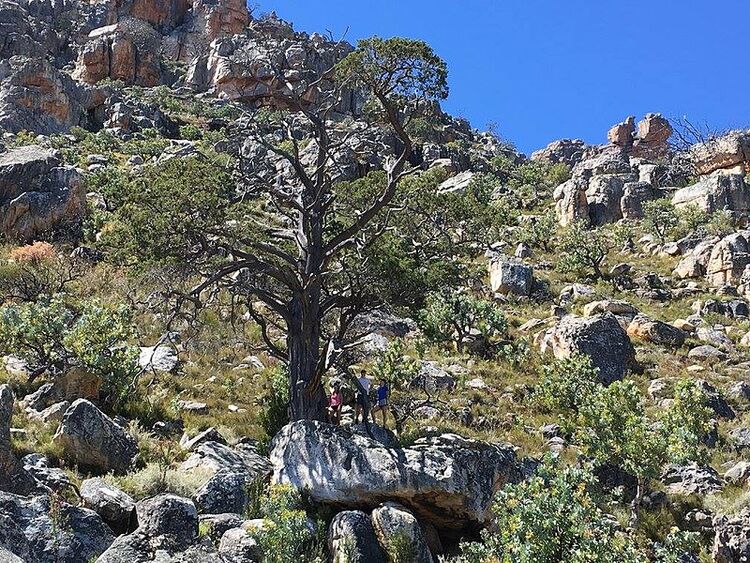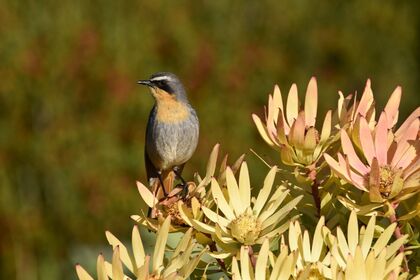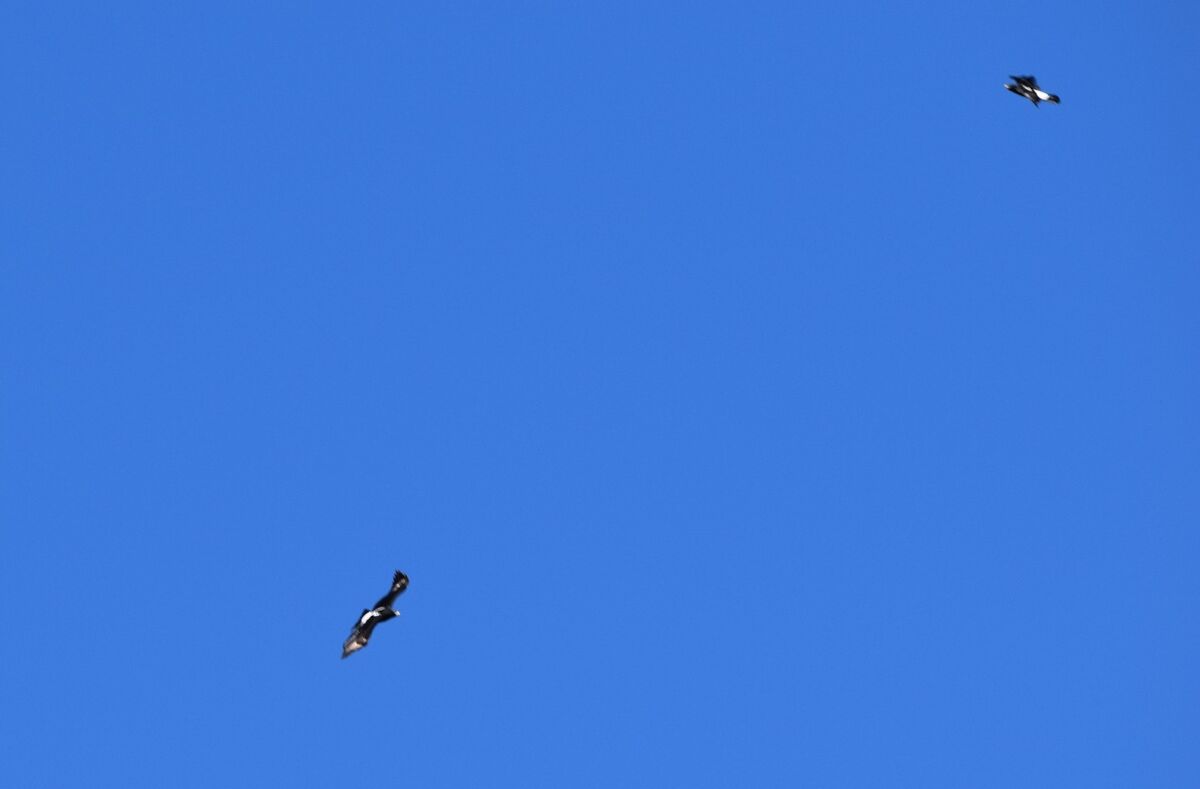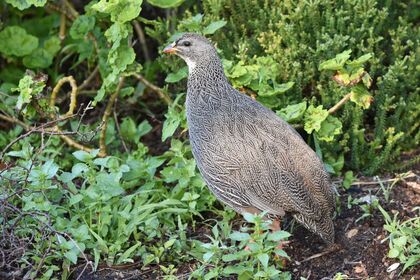
Birding in Cederberg - De Pakhuys
The Cederberg mountain range in the North part of the Western Cape is a truly unique part of the world. It is known for its mostly untouched rocky wind-shaped red standstone, and dense fynbos which provides diverse habitats for plant and animal life.
Mammals such as baboons, dassies and small antelope are common, while the only large predator to live in the area is the leopard - luckily they are very shy and stick to themselves. The plantlife in the area is also unique and the Cederberg mountains are named for the endanged and endemic Clanwilliam Cedar tree which only lives in Cederberg (the "Ceder" in the mountain range name is a mix of the English "Cedar" and Afrikaans "Seder").

Clanwilliam Cedar Tree
As for the birds, the area offers a completely unique birding experience - with a mixture of Cape, Karoo, Fynbos and Mountain species populating the mountains.
We went to the Cederberg mountains in mid-August - right in the middle of spring.
This part of the world is famous for the spectacular flower displays with fields of blooming colours as far as the eye can see. This is a bit early for the Summer migrant birds to be around, but this still has to be the best time of year to visit the area.

The Cederberg region is famous for its stunning natural flower displays in the Spring
The lodge we stayed at is called de Pakhuys, situated on the Northern side of Cederberg, a 10-minute drive from the official Cederberg nature reserve. The lodge is a situated on a working farm with surrounded by a lot of natural land, giving opportunities to explore right at your doorstep.

The Bokmakierie is named for its song, which is a classic sound of the South African wilderness.
Birding at De Pakhuys
We arrived at de Pakhuys after dark and were immediately greeted by a Cape Eagle-Owl on the way in. While braaing in the dark, we listened to the calls of the Freckled Nightjar, Helmeted Guineafowl, and Red Eyed Dove still calling in the night, as our excitement grew for what awaited us in the morning.
Before the sun had even come up, the Bokmakieries were ready to wake us up with their classic "bok-ma-kie-RIE" calls. The Southern Fiscals were also chatting away, and we were lucky enough to hear them mimicing the Bokmakierie call in their own grungy style. Egyptian Geese flew over, calling away at each other while the Red-Winged Starlings and Cape-Robin Chats sang their soft beautiful tunes. Although it was still cold, we had to get out of bed and experience the birds first hand.
Each room at de Pakhuys has its own patio overlooking different parts of the lodge. From here you can see plenty of birds already. Other than the noisy bunch mentioned above, Cape Buntings and Karoo Thrushes heavily populate the area and do not seem to mind the farming activities at de Pakhuys - testament to the sustainable approach taken by the team there.




As any birder would know, the presence of water brings about a lot of birdlife, and fortunately de Pakhuys has plenty of water. (At least) 3 dams can be found - 1 at the entrance gate, 1 near the olive orchards, and another near the campsite. The Brandewyn river also runs through de Pakhuys. This gives great access to a variety of water birds including the Giant Kingfisher, Little-Rush Warbler, Reed Cormorant, White-breasted Cormorant and Grey Heron.

Reed Cormorant in Non-Breeding Plumage
A number of the rooms at de Pakhuys are named after some of the local birds. We stayed in the room named "Witkruis" which was fitting as we saw 2 pairs of Verreaux's Eagles in the area (the Afrikaans name is "Witkruisarend" [White-cross Eagle]). This raptor is known for nesting on high cliffs and is easily recognisable through its mostly black plumage with white 'windows' on the wing and the white cross on its rump (lower back).

We saw this pair of Verreaux's Eagles. They commonly fly in pairs and can be recognised by their black plumage with bright white 'cross' on the back and white under the wings
Another common raptor in the area is the Jackal Buzzard - these large rufous and grey raptors are commonly seen sitting on telephone poles. The Rock Kestrel is also a regular and is often seen swooping near the cliffs and is famous for its ability to hover completely stationary while hunting.
The hikes at de Pakhuys also offer plenty of opportunities to see some of the region's specials. The hikes are along the river and up to the kloofs and go through montane fynbos and over rocky terrain. Common birds here are the Rock Martin, White-Throated Canary, Grey-Backed Cisticola, Cape Spurfowl, and Karoo Scrub-Robin. Some specials here are the Fairy Flycatcher (South Africa's smallest bird!), Pale-Winged Starling, Layard's Warbler, Grey Tit, Grey-winged Francolin and Cinnamon-Breasted Warbler. The hikes are estimated to take around 2 hours, but we ended up spending the entire morning at "birdwatching pace" - constantly held up to see what else was hopping around the rocks.








Birding in the Wider Cederberg Area
De Pakhuys is situated on the Pakhuis pass through the Cederberg mountains, and you would be remiss to not explore the mountains themselves. The Cederberg Nature Reserve is only a 15 minute drive from the entrance of de Pakhuys, where you can go to the Kliphuis campsite to get a day-permit to go hiking in the mountains - doing the hike around Pakhuisberg (free with a Wild Card!).
These mountains are truly spectacular and offer opportunities to see all of the above mentioned birds as well as some higher altitude specials. This includes the amazing Cape Rockjumper - 2021 Bird of the Year. We were lucky enough to see a female Rockjumper while hiking. This bird is not always easy to see as it is quite shy and can be hard to spot hopping around rocky, boulder strewn slopes. Your best bet is to learn the call and keep your ears open while walking - the Cape Rockjumper is a noisy bird with a distinctive call!

Although it was far away, we were able to catch this female Cape Rockjumper high up on a hike around Pakhuisberg
Cape Rockjumper Song
The Cape Rockjumper has a distinctive high-pitched call. It can vary from single notes, to an excited chattering with 1 or more birds. As it is typically hard to find hopping low to the ground in the rocks and fynbos, learning its call is one of your best chances to locate and see it.
Play SongSome other excellent birds that can be seen in the mountain areas are the Cape Siskin, Cape Clapper Lark and Sickle-Winged Chat.




De Pakhuys Lodge
De Pakhuys lodge is situated in Northern Cederberg along the similarly named "Pakhuis" mountain pass. The lodge itself is a veritable utopia for climbers who enjoy bouldering on the massive sandstone rocks contained within the lodge. The lodge is also an operational farm producing endemic rooibos (which only grows in this part of the world), olives, sheep and wine grapes.
As such, the lodge is surrounded by greenery and nature - each room is isolated and you cannot see any other rooms from your location. De Pakhuys features a number of dams, as well as a swimming pool, hikes to waterfalls and kloofs, and the aforementioned opportunities for rock climbing.
The rooms are very affordable, but leave nothing to be desired. Despite their low cost, they are fully fitted with beautiful modern finishes, kitchen, private braai and patio. Our focus is not on the rooms, but it has to be mentioned that we were pleasantly surprised by the quality of the accommodation. For those who are not as worried about the accommodation, or trying to save a little more money, de Pakhuys also offers camping in one of the most beautiful settings we have seen.
Bird List
There are few places that combine the various bird species from the Cape, the Karoo, the mountains and arid semi-deserts to the North. Take along our bird list to keep track of what you can find... How many can you tick off?

- De Pakhuys Bird List
- Raptors
- Buzzard, Jackal
- Eagle, African Fish
- Eagle, Booted
- Eagle, Martial
- Eagle, Verreaux's
- Eagle-Owl, Spotted
- Goshawk, Pale Chanting
- Harrier, Black
- Harrier-Hawk, African
- Kestrel, Rock
- Kite, Black-winged
- Local Specials
- Bunting, Cape
- Canary, Black-headed
- Canary, White-throated
- Flycatcher, Fairy
- Francolin, Grey-winged
- Lark, Cape Clapper
- Lark, Karoo
- Lark, Large-billed
- Nightjar, Freckled
- Rockjumper, Cape
- Siskin, Cape
- Spurfowl, Cape
- Sunbird, Orange-Breasted
- Tit, Grey
- Warbler, Cinnamon-breasted
- Warbler, Layard's
- Wheatear, Capped
- Wheatear, Mountain
- Our Common Friends
- Batis, Cape
- Bee-eater, European
- Bishop, Yellow
- Bokmakierie, Bokmakierie
- Bulbul, Cape
- Canary, Cape
- Chat, Ant-eating
- Chat, Familiar
- Cisticola, Grey-backed
- Coot, Red-knobbed
- Cormorant, Reed
- Cormorant, White-breasted
- Crombec, Long-billed
- Crow, Pied
- Darter, African
- Dove, Laughing
- Dove, Namaqua
- Dove, Red-eyed
- Dove, Ring-necked
- Duck, African Black
- Duck, Yellow-billed
- Fiscal, Southern
- Flycatcher, Fiscal
- Goose, Egyptian
- Goose, Spur-winged
- Grassbird, Cape
- Grebe, Little
- Hamerkop, Hamerkop
- Heron, Grey
- Ibis, Hadada
- Kingfisher, Giant
- Kingfisher, Malachite
- Lapwing, Blacksmith
- Lapwing, Crowned
- Lark, Red-capped
- Martin, Brown-throated
- Martin, Rock
- Moorhen, Common
- Mousebird, White-backed
- Ostrich, Common
- Pigeon, Speckled
- Pipit, African
- Plover, Three-banded
- Prinia, Karoo
- Raven, White-necked
- Robin, Karoo Scrub
- Robin-Chat, Cape
- Sandgrouse, Namaqua
- Sandpiper, Common
- Seedeater, Streaky-headed
- Shelduck, South African
- Sparrow, Cape
- Sparrow, House
- Spoonbill, African
- Starling, Pied
- Starling, Red-winged
- Stonechat, African
- Sunbird, Malachite
- Sunbird, Southern Double-collared
- Swallow, Greater Striped
- Swallow, White-throated
- Swift, Alpine
- Swift, White-rumped
- Thick-knee, Spotted
- Thrush, Karoo
- Thrush, Olive
- Wagtail, Cape
- Warbler, Little Rush
- Waxbill, Common
- Weaver, Cape
- Weaver, Southern Masked
- White-eye, Cape
- Woodpecker, Cardinal
- Others
- __________________________
- __________________________
- __________________________
- __________________________
- __________________________
- __________________________
- __________________________
- __________________________
- __________________________
- __________________________
- __________________________
- __________________________
- __________________________
- __________________________
- __________________________
- __________________________
- __________________________
- __________________________
- __________________________
- __________________________
- __________________________
- __________________________





